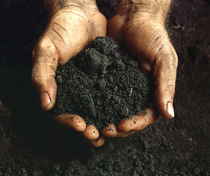
Arkansas Symbols
Arkansas State Soil
Stuttgart soil series

(Fine, smectitic, thermic Albaquultic Hapludalfs )
Adopted in 1997.
The Stuttgart soil series was adopted as the Arkansas state soil by the Eighty-first General Assembly of 1997. The Stuttgart silt loam series formed on a vast Pleistocene-aged stream terrace in level or nearly level topography and occupies approximately 200,000 acres (81,000 hectares) in eastern Arkansas. It has a silt loam textured loess-alluvium mixed surface layer underlain by silt loam to silty clay loam alluvial deposits of the old Pleistocene stream terrace. The primary crops grown on the Stuttgart series are rice and soybeans, and it is one of the most productive soils in the state, responsible for millions of dollars of crop harvest each year. The city of Stuttgart (Arkansas County) owes its existence in part to the Stuttgart silt loam soil.
Arkansas State Soil: Stuttgart soil series

A state soil is represented by a soil series that has special significance to a particular state. Each state in the United States has selected a state soil, fifteen of which have been legislatively established. These "Official State Soils" share the same level of distinction as official state flowers and birds.
Stuttgart soils are named for the City of Stuttgart in Southeast Arkansas. They are used primarily for cropland with the dominant crops being rice, soybeans, small grains, and corn. The Stuttgart area is famous for its large fall and winter population of ducks and geese. These waterfowl feed heavily on the crops grown on the Stuttgart soils. Stuttgart soils have been mapped on about 200,000 acres in Arkansas. The Stuttgart series consists of very deep moderately well to somewhat poorly drained soils formed in silty and clayey alluvium. These level to gently sloping soils are on Prairie terraces in the Lower Mississippi Valley. Stuttgart's silt loam surface texture and the slow permeability in its clayey subsoil makes the soil ideal for rice population.
Typical Stuttgart Soil Profile
- Surface: 0 to 11 inches - dark grayish brown and grayish brown silt loam
- Subsurface: 11 to 23 inches - yellowish brown silt loam
- Subsoil: 23 - 35 inches - red silty clay; 35 - 80 inches - grayish brown and light brownish gray silty clay loam
Soil Family Classification
Fine, smectitic, thermic Albaquultic Hapludalfs
Stuttgart soils are in the Alfisols soil order. Alfisols are mostly soils of intermediate age. The "Albaquultic" subgroup implies that the soil has an abrupt textural change, has a moderately high water table during part of the year, and that the base saturation is less than 60 percent at 50 inches below the top of the subsoil. The term "fine" indicates that the upper subsoil averages between 35 and 60 percent clay. The term "smectitic" implies that the clay in the subsoil is dominated by minerals that expand upon wetting and contract upon drying. "Thermic" refers to an average annual soil temperature of between 15o to 22oC (59o to 72oF).
Arkansas Law
The law designating the Stuttgart soil series as the official Arkansas state soil is found in the Arkansas Code, Title 1, Chapter 4, Section 1-4-124.
Title 1 - General Provisions
Chapter 4 - State Symbols, Motto, Etc.
1-4-124. State soil.
The Stuttgart soil series, member of a soil family of fine, smectitic, thermic albaquultic hapludalfs, is hereby designated and declared as the official
Arkansas state soil.
History. Acts 1997, No. 890, § 1






